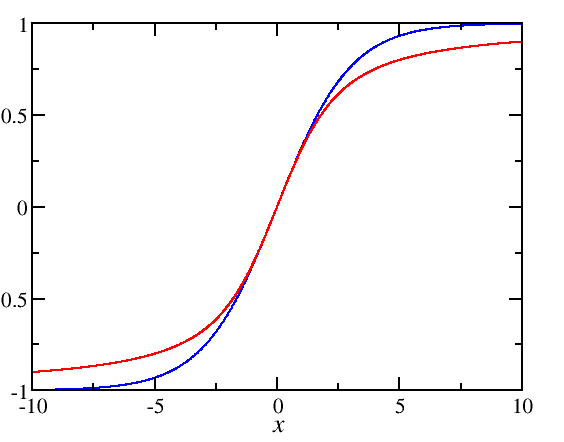- Brillouin and Langevin functions
=Brillouin Function=
The Brillouin functionC. Kittel, "Introduction to Solid State Physics" (8th ed.), pages 303-4] [Citation
last = Darby
first = M.I.
author-link =
last2 =
first2 =
author2-link =
title = Tables of the Brillouin function and of the related function for the spontaneous magnetization
journal = Brit. J. Appl. Phys.
volume = 18
issue =
pages = 1415-1417
date =
year = 1967
url =
doi =
id = ] is aspecial function defined by the following equation::
The function is usually applied (see below) in the context where "x" is a real variable and "J" is a positive integer or half-integer. In this case, the function varies from -1 to 1, approaching +1 as "x" approaches +∞ and -1 as "x" approaches -∞.The function is best known for arising in the calculation of the
magnetization of an idealparamagnet . In particular, it describes the dependency of the magnetization on the appliedmagnetic field and thetotal angular momentum quantum number J of the microscopicmagnetic moment s of the material. The magnetization is given by::where
* is the number of atoms per unit volume,
* theg-factor ,
* theBohr magneton ,
* is the ratio of the Zeeman energy of the magnetic moment in the external field to the thermal energy :::
* is theBoltzmann constant and the temperature.:
Langevin Function
thumb|right|Langevin function (red line), compared with"> (blue line).In the classical limit, the moments can be continuously aligned in the field and can assume all values (). The Brillouin function is then simplified into the Langevin function, named after
Paul Langevin ::
High Temperature Limit
When i.e. when is small, the expression of the magnetization can be approximated by the
Curie's law ::
where is a constant. One can note that is the effective number of Bohr magnetons.
High Field Limit
When , the Brillouin function goes to 1. The magnetization saturates with the magnetic moments completely aligned with the applied field:
:
References
Wikimedia Foundation. 2010.

